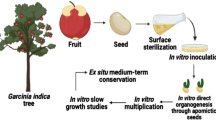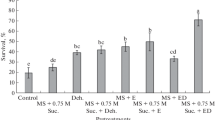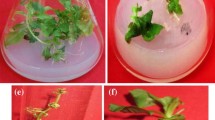Abstract
Contamination-free, simple, cheap and efficient protocol for long term in vitro conservation of Ipsea malabarica (Reichb. f.) J.D. Hook, `the Malabar Daffodil Orchid', an endemic and endangered orchid of the Western Ghats of Kerala at the whole plant level was achieved. Strategies such as reduction in salt strength and medium with or without hormone/sugar were adopted for conservation in vitro. Culture vessel type significantly influenced the period of storage. Jam bottles were superior to test tubes for conservation. Half-strength Murashige and Skoog (MS) medium with 3% sugar and 1.5 mg l−1 kinetin in jam bottles facilitated storage of shoots up to 14 months without subculture which developed 25 shoots. Elimination of sugar from the above medium increased the storage period to 20 months. The shoots on this medium exhibited reduced growth and developed less than 12 shoots. Half-strength growth regulator free medium with sugar exhibited very slow growth and developed less than five shoots. This medium facilitated storage up to 20 months. Half-strength MS growth regulator and sugar free (photoautotrophic) medium was best for in vitro conservation and the storage period on this medium was 27 months. On this medium, the shoots grew very slowly and rarely developed another shoot. The culture was also free of contamination. Since 1997, about 100 of this threatened orchid have been maintaining in vitro at whole plant level.
Similar content being viewed by others
References
Chetia S, Deka PC & Devi J (1998) Germination of fresh and stored encapsulated protocorms of orchids. Indian J. Exp. Biol. 36: 108-111
Datta KB, Kanjilal B & De Sarker D (1999) Artificial seed technology: development of a protocol in Geodorum densiflorum (Lam) Schltr. - An endangered orchid. Curr. Sci. 76: 1142-1145
Kozai T (1991) Photoautotrophic micropropagation. In Vitro Cell. Dev. Biol. 271: 47-51
Leifert C, Marris C & Waites WM (1994) Microbial contaminants and pathogens of plant tissue cultures. CRC Crit. Rev. Plant Sci. 13: 139-183
Mantell SH (1998) Microbes intimately associated with tissue and cell cultures of tropical Dioscorea yams. Plant Cell Tiss. Org. Cult. 52: 47-52
Maruyama E, Kinoshita I, Ishii K, Ohba K & Saito A (1997) Germplasm conservation of the tropical forest trees Cedrela odorata L., Guazuma crinita Mart. and Jacaranda mimosaefolia D. Don., by shoot tip encapsulation in calcium-alginate and storage at 12-25 8C. Plant Cell Rep. 16: 393-396
Mitra A, Bhattacharaya PS, Dey S, Sawarker SK & Bhattacharayya BC (1998) Photoautotrophic in vitro culture of Chrysanthemum under CO enrichment. Biotech. Tech. 12: 335-337 2
Murashige T & Skoog F (1962) A revised medium for rapid growth and bioassays for tobacco tissue cultures. Physiol. Plant. 15: 473-497
Author information
Authors and Affiliations
Corresponding author
Rights and permissions
About this article
Cite this article
Martin, K., Pradeep, A. Simple strategy for the in vitro conservation of Ipsea malabarica an endemic and endangered orchid of the Western Ghats of Kerala, India. Plant Cell, Tissue and Organ Culture 74, 197–200 (2003). https://doi.org/10.1023/A:1023971625994
Issue Date:
DOI: https://doi.org/10.1023/A:1023971625994




